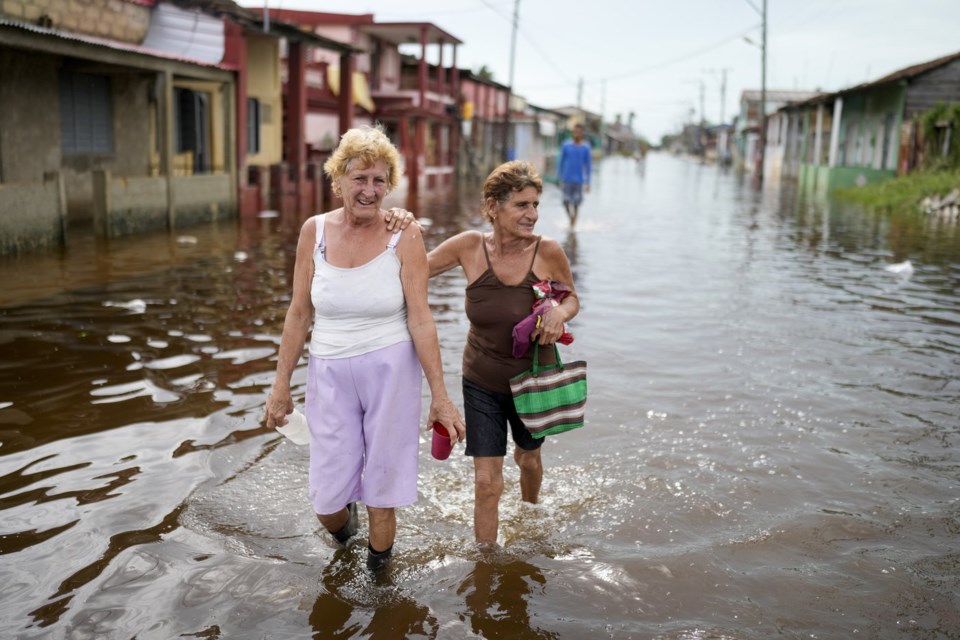HAVANA (AP) — Cuba was left reeling Thursday after a fierce Category 3 hurricane ripped across the island, destroying hundreds of homes, knocking out the country’s power grid and damaging other infrastructure.
No fatalities were immediately reported in Cuba, and Hurricane Rafael had weakened to a Category 2 storm as it swirled across the gulf toward Mexico where heavy rains were expected in the coming days.
Rafael crossed a western portion of Cuba on Wednesday evening about 75 kilometers (45 miles) west of Havana, where José Ignacio Dimas returned home from his night shift as a security guard to find his apartment building in the historic center of the city had collapsed.
“The entire front wall of the building fell,” José Ignacio Dimas said in a tight voice as he scanned the damage early Thursday. Like many buildings in the capital, it was aging and lacked maintenance.
More than 461 homes collapsed because of the hurricane, Cuban authorities said. More than 283,000 people from across the country had been evacuated from their homes, 98,300 of which were in Havana, according to authorities.
Streets across the western swath of the country were riddled with utility poles, wires and trees.
In Havana, residents picked up what debris they could, but huge trees and fallen telephone lines lined the ground, blocking traffic. Concerned about food going bad due to blackouts, a group of residents opened an informal soup kitchen.
"If we don’t work together as neighbors, nobody does it,” said Ariel Calvo, who was helping to shovel debris Thursday morning.
Lázaro Guerra, electricity director for the Ministry of Energy and Mines, said power had been partially restored in the island’s western region and that generation units were powering back up. But he warned that restoring power would be slow-going as crews took safety precautions.
On Thursday morning, the hurricane was located about 260 miles (420 kilometers) west-northwest of Havana. It had maximum sustained winds of 105 mph (165 kph) and was moving west-northwest at 9 mph (15 kph).
Earlier in the week, Rafael brushed past Jamaica and battered the Cayman Islands, downing trees and power lines and unleashing heavy flooding in some areas.
Authorities in Jamaica are searching for a couple last seen inside a car that was swept away by floodwaters, police told Radio Jamaica News.
Thousands of customers in Jamaica and Little Cayman remained without power as crews worked to restore electricity after the storm.
Rafael was expected to keep weakening as it spins over open waters and heads toward northern Mexico, although the hurricane center warned there was “above average uncertainty” in the storm's future track.
Meanwhile, many Cubans were left picking up the pieces from Wednesday night, after a rocky few weeks in the Caribbean nation. In October, the island was hit by a one-two punch. First, it was hit by island-wide blackouts stretching on for days, a product of the island’s energy crisis. Shortly after, it was slapped by powerful hurricane that struck the eastern part of the island and killed at least six people.
The disasters have stoked discontent already simmering in Cuba amid an ongoing economic crisis, which has pushed many to migrate from Cuba.
Classes and public transport were suspended on parts of the island and authorities canceled flights in and out of Havana and Varadero. Thousands of people in the west of the island had been evacuated as a preventative measure.
Rafael is the 17th named storm of the season.
The National Oceanic and Atmospheric Administration predicted the 2024 hurricane season was likely to be well above average, with between 17 and 25 named storms. The forecast called for as many as 13 hurricanes and four major hurricanes.
An average Atlantic hurricane season produces 14 named storms, seven of them hurricanes and three major hurricanes.
Andrea Rodríguez, The Associated Press




